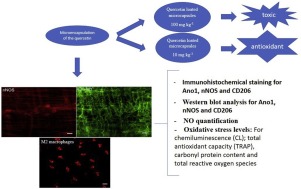当前位置:
X-MOL 学术
›
Neurotoxicology
›
论文详情
Our official English website, www.x-mol.net, welcomes your feedback! (Note: you will need to create a separate account there.)
Anti- and pro-oxidant effects of quercetin stabilized by microencapsulation on interstitial cells of Cajal, nitrergic neurons and M2-like macrophages in the jejunum of diabetic rats.
NeuroToxicology ( IF 3.4 ) Pub Date : 2020-01-30 , DOI: 10.1016/j.neuro.2020.01.011 Flávia Cristina Vieira-Frez 1 , Camila Caviquioli Sehaber-Sierakowski 1 , Juliana Vanessa Colombo Martins Perles 1 , Gleison Daion Piovezana Bossolani 1 , Waldiceu Aparecido Verri 2 , Rafael Campos do Nascimento 1 , Flávia Alesandra Guarnier 2 , Heloíza Paranzini Bordini 2 , Fernanda Pachoal Blegniski 2 , Heber Amilcar Martins 1 , Sara Raquel Garcia de Souza 1 , Fabiana Galvão da Motta Lima 1 , Mariana Machado Lima 1 , Bruna Thais Silva 1 , Camila Cristina Iwanaga 1 , Jacqueline Nelisis Zanoni 1
NeuroToxicology ( IF 3.4 ) Pub Date : 2020-01-30 , DOI: 10.1016/j.neuro.2020.01.011 Flávia Cristina Vieira-Frez 1 , Camila Caviquioli Sehaber-Sierakowski 1 , Juliana Vanessa Colombo Martins Perles 1 , Gleison Daion Piovezana Bossolani 1 , Waldiceu Aparecido Verri 2 , Rafael Campos do Nascimento 1 , Flávia Alesandra Guarnier 2 , Heloíza Paranzini Bordini 2 , Fernanda Pachoal Blegniski 2 , Heber Amilcar Martins 1 , Sara Raquel Garcia de Souza 1 , Fabiana Galvão da Motta Lima 1 , Mariana Machado Lima 1 , Bruna Thais Silva 1 , Camila Cristina Iwanaga 1 , Jacqueline Nelisis Zanoni 1
Affiliation

|
Given the well-known antioxidant and neuroprotective properties of quercetin, the aim of this work was to evaluate the effects of quercetin stabilized by microencapsulation at two doses (10 mg kg-1 and 100 mg kg-1) on the oxidative/antioxidant status, number and morphological features of ICC, nitrergic neurons and M2-like macrophages in jejunum of diabetic rats. The rats were randomly distributed into six groups: normoglycemic control (N), diabetic control (D) and either normoglycemic or diabetic groups treated with quercetin-loaded microcapsules at a dose of 10 mg kg-1 (NQ10 and DQ10, respectively) or 100 mg kg-1 (NQ100 and DQ100, respectively). After 60 days, the jejunum was collected. Whole mounts were immunostained for Ano1, nNOS and CD206, and oxidative stress levels and total antioxidant capacity of the jejunum were measured. Diabetes led to a loss of ICC and nitrergic neurons, but increased numbers of M2-like macrophages and elevated levels of oxidative stress were seen in diabetic animals. High-dose administration of quercetin (100 mg kg-1) further aggravated the diabetic condition (DQ100) but this treatment resulted in harmful effects on healthy rats (NQ100), pointing to a pro-oxidant activity. However, low-dose administration of quercetin (10 mg kg-1) gave rise to antioxidant and protective effects on ICC, nNOS, macrophages and oxidative/antioxidant status in DQ100, but NQ100 displayed infrequent negative outcomes in normoglycemic animals. Microencapsulation of the quercetin may become promising alternatives to reduce diabetes-induced oxidative stress but antioxidant therapies should be careful used under healthy status to avoid toxic effects.
中文翻译:

微囊化稳定的槲皮素对糖尿病大鼠空肠Cajal,硝酸能神经元和M2样巨噬细胞间质细胞的抗氧化和促氧化作用。
鉴于槲皮素众所周知的抗氧化和神经保护特性,这项工作的目的是评估通过微囊化两种剂量(10 mg kg-1和100 mg kg-1)稳定的槲皮素对氧化/抗氧化状态的影响,大鼠空肠中ICC,硝化神经元和M2样巨噬细胞的数量和形态特征 将大鼠随机分为六组:正常血糖对照组(N),糖尿病对照组(D)和用槲皮素微胶囊以10 mg kg-1(分别为NQ10和DQ10)或100剂量治疗的正常血糖组或糖尿病组mg kg-1(分别为NQ100和DQ100)。60天后,收集空肠。整个坐骑对Ano1,nNOS和CD206进行免疫染色,并测量空肠的氧化应激水平和总抗氧化能力。糖尿病导致ICC和神经能神经元的丧失,但是在糖尿病动物中发现了M2样巨噬细胞数量增加和氧化应激水平升高。大剂量槲皮素(100 mg kg-1)进一步加重了糖尿病病情(DQ100),但这种治疗对健康大鼠(NQ100)产生了有害影响,表明其具有促氧化作用。然而,低剂量的槲皮素(10 mg kg-1)对DQ100的ICC,nNOS,巨噬细胞和氧化/抗氧化状态产生抗氧化和保护作用,但NQ100在正常血糖动物中很少出现阴性结果。槲皮素的微囊化可能会成为减少糖尿病引起的氧化应激的有前途的替代方法,但在健康状态下应谨慎使用抗氧化剂疗法,以避免毒性作用。
更新日期:2020-01-31
中文翻译:

微囊化稳定的槲皮素对糖尿病大鼠空肠Cajal,硝酸能神经元和M2样巨噬细胞间质细胞的抗氧化和促氧化作用。
鉴于槲皮素众所周知的抗氧化和神经保护特性,这项工作的目的是评估通过微囊化两种剂量(10 mg kg-1和100 mg kg-1)稳定的槲皮素对氧化/抗氧化状态的影响,大鼠空肠中ICC,硝化神经元和M2样巨噬细胞的数量和形态特征 将大鼠随机分为六组:正常血糖对照组(N),糖尿病对照组(D)和用槲皮素微胶囊以10 mg kg-1(分别为NQ10和DQ10)或100剂量治疗的正常血糖组或糖尿病组mg kg-1(分别为NQ100和DQ100)。60天后,收集空肠。整个坐骑对Ano1,nNOS和CD206进行免疫染色,并测量空肠的氧化应激水平和总抗氧化能力。糖尿病导致ICC和神经能神经元的丧失,但是在糖尿病动物中发现了M2样巨噬细胞数量增加和氧化应激水平升高。大剂量槲皮素(100 mg kg-1)进一步加重了糖尿病病情(DQ100),但这种治疗对健康大鼠(NQ100)产生了有害影响,表明其具有促氧化作用。然而,低剂量的槲皮素(10 mg kg-1)对DQ100的ICC,nNOS,巨噬细胞和氧化/抗氧化状态产生抗氧化和保护作用,但NQ100在正常血糖动物中很少出现阴性结果。槲皮素的微囊化可能会成为减少糖尿病引起的氧化应激的有前途的替代方法,但在健康状态下应谨慎使用抗氧化剂疗法,以避免毒性作用。



























 京公网安备 11010802027423号
京公网安备 11010802027423号